Redmine Review
Redmine has the distinction of being one of the few open-source and completely free project management tools out there. To find out if it’s any good, join us for our full Redmine review.
Redmine is an interesting piece of project management software. It’s entirely free and open source, a breath of fresh air in an industry where even the best free project management software comes with a number of caveats. Whether it’s the right fit for you, though, is the subject of this Redmine review. Follow along as our project management experts take a deep dive into the service.
Key Takeaways:
- Redmine is not a user-friendly solution. At times, it may seem deliberately created to frustrate you. Get past that, though, and Redmine has a lot going for it.
- Redmine comes without the backend installed, meaning you need to know how to set up your own database or you need to pay separately for a person or service to do it.
- Redmine’s core package is not that interesting, but its wealth of add-ons and integrations make up for it. There’s a versatile project management solution here, if you put some effort into it.
The short version is, while there is a lot to like in Redmine, we won’t be awarding it a spot in our best project management software roundup, which you can read for an alternative. This is because getting it to work is a project in and of itself. If you’re not comfortable getting into the guts of your machine, it’ll take you a few hours just to set it up.
The upside is that once you get it started — and understand the how and why of its inner workings — Redmine is a nifty piece of project management software, especially for software development teams. It has some weaknesses, but they’re made up for by its flexibility and the fact it’s not costing you a penny.
However, if you don’t like to tinker with software, we recommend giving Redmine a pass and checking out our monday.com review instead. It’s a lot more user-friendly and the one-click install will take just a few minutes rather than a few hours. Still, if you want to know more about Redmine, stick around for this full review.
Avoid Costly Project Management Mistakes – Get Free Tips Today!

- Discover 10 fundamentals of project management
- Understand step-by-step plans for PM execution
- Learn tips to avoid 5 common mistakes by beginners
-
11/19/2021 Facts checked
Rewrote the review with new criteria and images.
Alternatives for Redmine
- 1
- 2
- 3
- 4$10 / month(All Plans)
- 5$15 / month(All Plans)
- 6$15 / month(All Plans)
Strengths & Weaknesses
Pros:
- Free
- Extremely versatile
- Highly customizable
- Open-source software
Cons:
- Tough to install
- Tricky to use
Features
When it comes to features, Redmine is in the middle of the pack right out of the box. Its real strength lies in the many plugins that have been developed for it, each of which adds interesting functionality. You can read our Trello review to learn about a tool with a comparable approach. That said, we will be focusing on the Redmine core for this review.
Unlike most project management software, Redmine expects you to bring your own database to the party. We go over this more below, but this means you’ll need to be able to set up an SQL database and have a passing familiarity with the Ruby on Rails framework. If you don’t, you may want to check out our Asana review for something more digestible.
That said, this all makes Redmine extremely flexible. It advertises itself as “cross-platform and cross-database,” which in layman’s terms means it will work on anything, anywhere. It’s a great solution for distributed teams and a great example of what open-source project management software can do.
A Project Management Tool for Developers
As you can imagine, something that requires this much development knowledge also caters to developers. The standard types of tasks — called “issues,” the tell-tale sign of somebody who has been reading up on the Agile methodology — center around creating new features, bug tracking and support tasks.
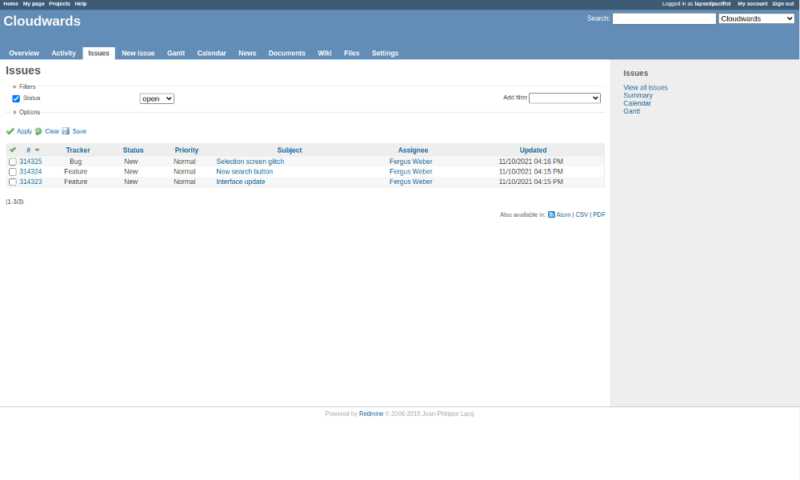
Many of the other features Redmine offers are also reminiscent of the best scrum tools. There’s a built-in wiki editor, so you can easily collect notes. There’s also a built-in forum, which is great for remote teams, and a dedicated time-tracking feature, which we wish more project management software would include as standard (read our nTask review for another example).
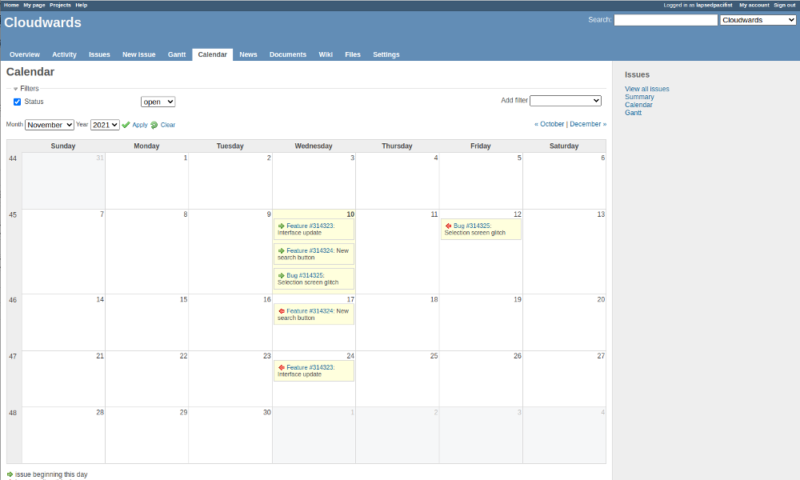
The last of Redmine’s major features is its Gantt charts, which it advertises heavily. We’re not sure why, though, as they’re not that great. They’re a basic sideways bar chart, a far cry from the power and versatility of dedicated tools like TeamGantt (read our TeamGantt review).
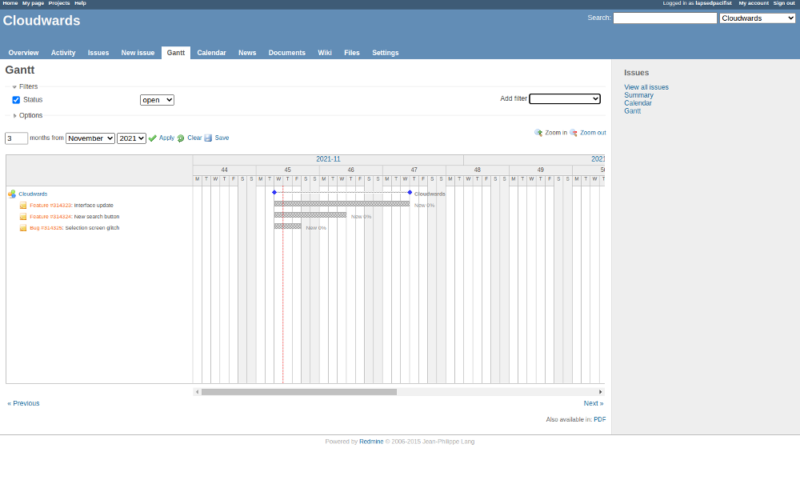
There’s also a lot missing in Redmine’s core features, most notably a kanban board (though it’s one of the many plugins you can add). Why one of the most useful tools was left out of the core package will have to remain a mystery. It leaves Redmine a little underwhelming, but looking at the basic package is only scratching the surface.
Managing Projects With Plugins
While it can only do so much as it is, Redmine is open-source software that runs on Ruby on Rails, so it’s easy to develop plugins for it. Many of its most ardent fans have taken this as a challenge, leading to thousands of add-ons. The developers even offer an official plugin directory where you can browse at your leisure.
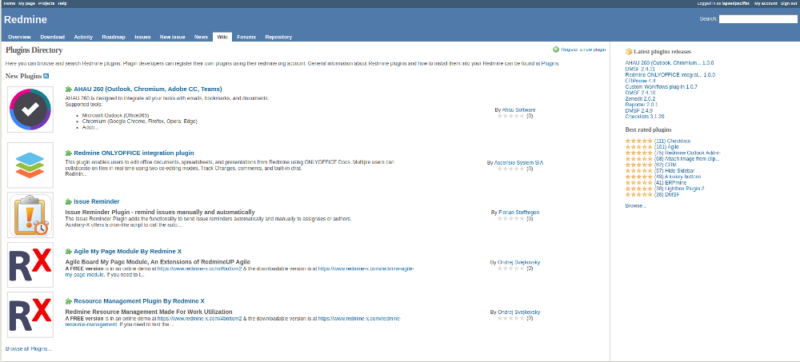
These Redmine plugins run the gamut from added resource management to improve email notifications to specialized tools for small businesses (and large ones, too). We won’t list them all, but if you’re interested in Redmine, we recommend browsing through the directory to see if there’s anything you need.
On top of what’s in the approved directory, there are a lot of commercial Redmine products. Some are simple, adding just one tool for a reasonable price, while others can only be described as plugin suites. These offer multiple tools, or even build a new project management tool on the foundation laid by Redmine.
One of the most popular seems to be Easy Redmine, which advertises itself as a Redmine platform instead of a project management solution. We have little to no experience with it, but we recommend giving its free trial a shot if you’re interested. It seems perfect for a company that wants what Redmine can do but needs something easier to use.
Redmine Features Overview
| Features | |
|---|---|
| Kanban board | |
| List | |
| Calendar | |
| Timeline | |
| Spreadsheet view | |
| Gantt charts | |
| Workload planning | |
| Long-term planning | |
| Multiple project management | |
| Dependency management | |
| Native scrum management | |
| Set user permissions | |
| File storage | |
| Time-tracking | |
| Built-in integrations | |
| Reporting features | |
| Free plan | |
| Free Trial | |
| Web app | |
| Windows | |
| MacOS | |
| Android | |
| iOS | |
| AI Tools | |
| Ticket-based support | |
| Tutorials | |
| Knowledgebase | |
| Forum | |
| Live chat | |
| Phone support |
Pricing
Though we’re not blown away by Redmine’s core package, we do like its price, which is entirely free. There’s no free version with limitations or a free plan that caps the amount of users or actions you can take. It’s free. All you need is elbow grease to get it working, and much the same goes for many of its plugins.
Redmine Pricing
You can’t argue with this pricing scheme, and it makes it easy to forgive Redmine’s faults. You’re not owed much because you’re not really a customer.
Of course, there are scenarios where you will pay for Redmine. There’s a host of paid, commercial add-ons, like Easy Redmine, that will cost you a pretty penny. Even then, though, they’re going to be at least a little cheaper than other project management programs, simply by virtue of using a free framework.
If you want to save money on project management, Redmine and its many offshoots may be worth investigating. Some usability issues are a small price to pay for these savings.
User-Friendliness
Redmine is not a user-friendly project management solution unless you’re familiar with SQL databases, and even then, it’s not great. As reviewers, we’ve worked with a lot of types of software, and Redmine is one of the most complicated we’ve come across.
The fun starts when installing Redmine, right after creating your free account. Depending on your operating system, the process can be quite different. Here are the walkthroughs for the installation on Windows and Ubuntu Linux. We installed it on Linux and, well, let’s just say the process embodied a popular meme.
Even on Windows, it was an experience, to say the least. Besides downloading the files for Redmine, you need to install and configure MySQL (or another flavor of SQL) and set up Ruby. If none of these terms make you go, “yeah, I know that,” or “yeah, I have that installed,” you may want to check out monday.com or Asana for your project management needs instead.
In the end, we opted to use the publicly available Redmine demo to test it. This was to make sure we had access to all its features, just in case we fouled up the installation somewhere.
Redmine’s Interface
The web app’s interface is simple. Essentially, there’s just two screens. One is called “my page,” which acts like a personal dashboard, and the other is called “projects,” which, unsurprisingly, is where you can find your projects. In the demo, where anybody can make a project, the “projects” page looks chaotic.

If you’re wondering where the selection buttons for these two screens are, they’re in the top left and very, very small. Even on your author’s massive monitor, they’re about the size of a gnat. You get used to it quickly, but it’s a mystery why they’re this tiny.
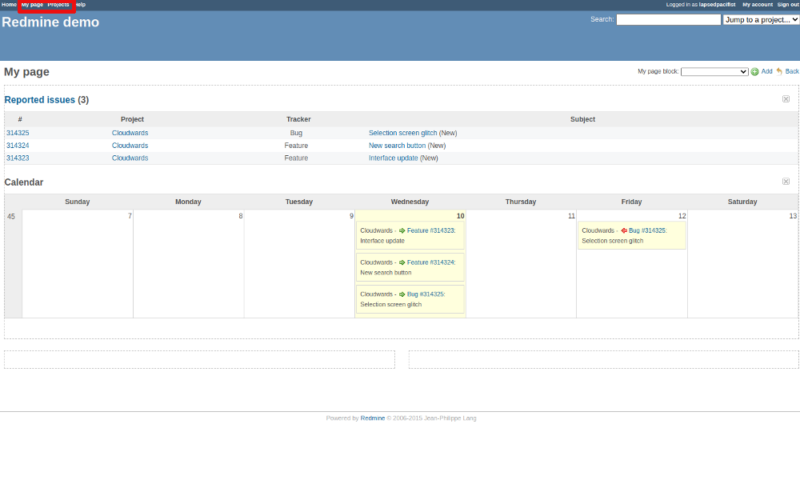
Picking a project transports you to its own dashboard, which gives you an overview of the bugs, features and support items that are open — in case you weren’t convinced it’s aimed as software developers — as well as a large number of tabs for navigation between the different views.
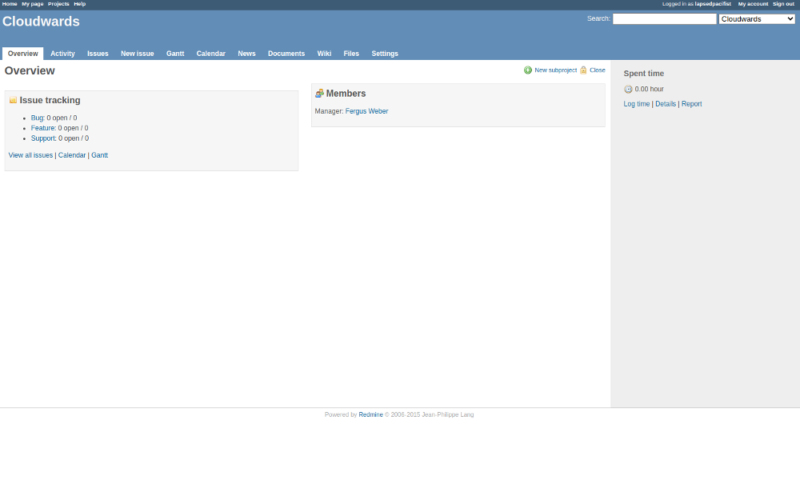
The dashboard is great. What we like less is how Redmine handles overall. It’s old school, which isn’t necessarily bad (read our Wrike review for an example of old-school cool), but some of its functionality has been vastly improved upon in the last 10 or so years. One example can be found when creating a new issue or project.
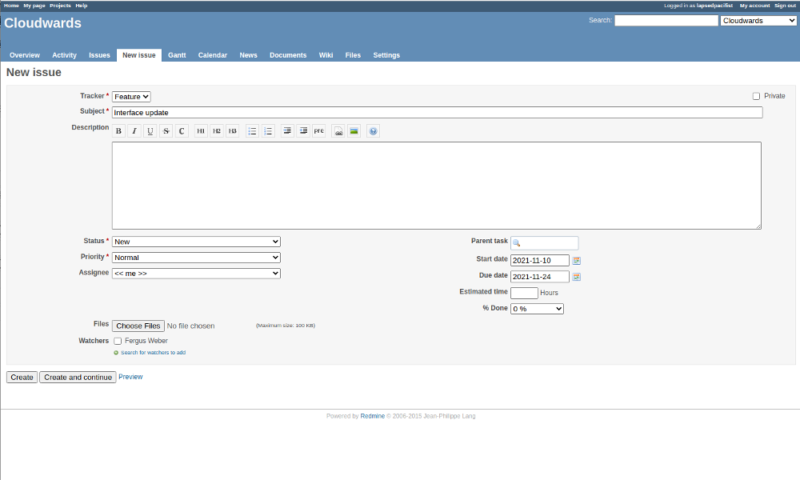
When creating a new issue, you can choose between a host of options, which is great, but it’s all handled through dropdown menus, which can get annoying if you need to create many issues in a row. It’s a small gripe, but making a batch of new tasks becomes a terrible clickfest with Redmine.
That’s not all, either. If there’s a problem with an issue — say you messed up the type or the date — you can’t change it on the fly. You have to find the issue, call up the details screen, then manually change it. If you’ve made several mistakes, you have to do the whole process as many times. Design like this makes task management a real headache.
Customize Redmine
That’s the bad, but Redmine has a few saving graces, too, namely how easy it is to customize. For example, when creating a new project, you get a lot of choices about what to add. You can pick and choose the modules you do and don’t need, as well as issue types.
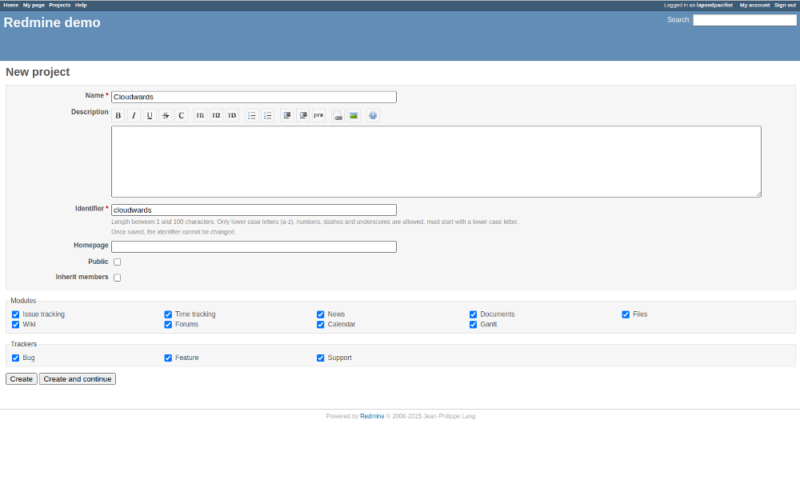
If you’d like to modify these choices, or add new ones, all you need to do is go to the settings screen. There, you can change what you like without too much fuss. It’s a solid way to tailor the program the way you want it, and we wish other project management software was as flexible.
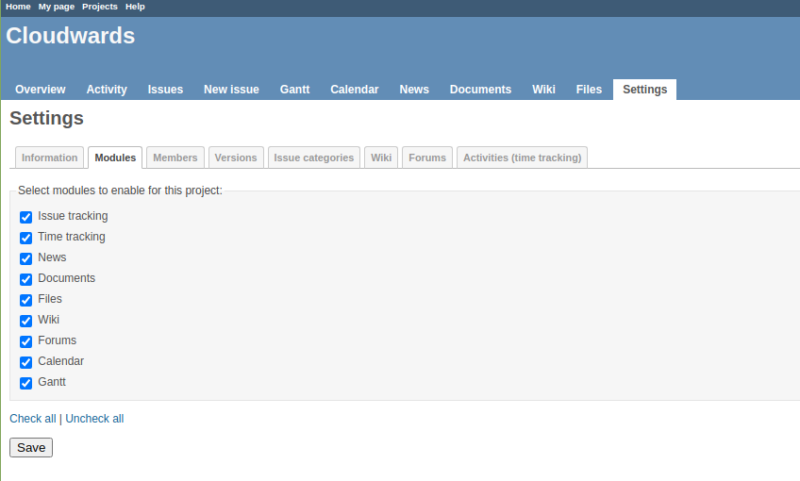
That said, we feel there could be more of a middle road between usability and customizability. Overall, Redmine is hard to handle and we wouldn’t recommend it for most users.
Security & Privacy
The way Redmine is set up, security and privacy are, more or less, your problem. This means if you botch the job, your data could be open to the world for all to see. On the flipside, do a good job and you’re better off than you would be with any commercial project management solution. For one, you won’t be stuck storing data with Amazon Web Services like most other tools do.
Instead, since you create your own databases, you’re responsible for what happens to them. In the case of data privacy, this means unless you share the contents of a database yourself, you don’t need to worry. The only privacy policy Redmine provides is for its website. We like this document as it lays out clearly what it does and does not store, and why.
Of course, any third-party add-ons you may use have their own terms and conditions, so you will want to go over those before you install them, especially since some will have access to all the data you’ve entered into Redmine.
Redmine Security
Redmine also provides little in the way of security, though its community is always hard at work finding and patching issues (you can get an overview of these here). While the databases you can use, like MySQL, provide some native security, you may want to keep a close eye on what’s going on with Redmine if you’re worried about being the target of an attack.
Thankfully, there are tools to help you, like this Redmine security scanner by Planio, as well as the security advisories put out by Redmine. Though taken together, it may seem daunting, that’s the price for the freedom open-source software gives you.
Service & Support
Much like anything else, you’re more or less on your own when it comes to Redmine support. There’s no help lines or ticketing system. You’re dependent entirely on documentation and the forums. Luckily, the documentation is extensive and the forums are full of helpful people, so you should be okay, you may just need a little persistence.
Redmine’s guides are thorough in getting you started, but they can be terse. They’re made with the average user in mind, not for the lowest common denominator, as with commercial solutions. As such, instructions will often assume you’ve read other articles or know how to handle a preceding step. Thankfully, everything is interlinked, wiki-style.
As a result, you may find yourself flipping through more pages than you’d expect, especially when getting started. Still, if you take the time at the beginning, you should be able to handle everything Redmine throws at you later.
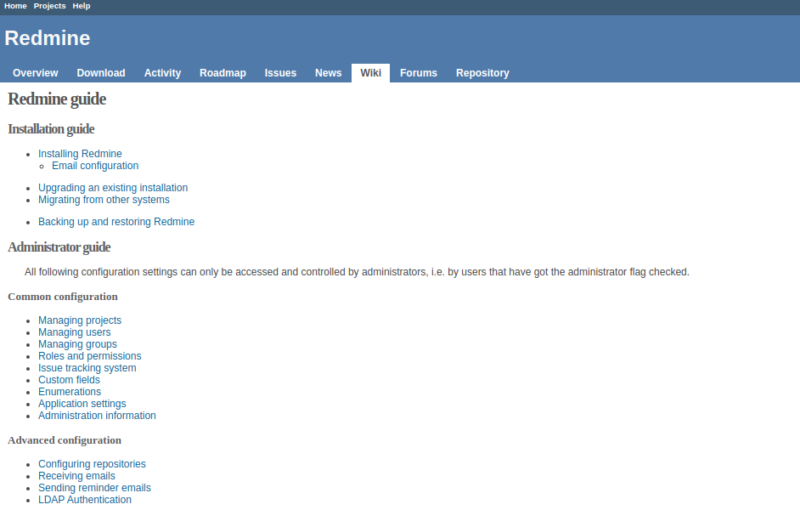
Redmine Forums
If you have issues not covered by the guides, Redmine’s forums should be able to help you. However, since it’s largely Redmine users helping each other, with only minimal input from the developers, you are expected to do your own homework and try different solutions before asking for help.
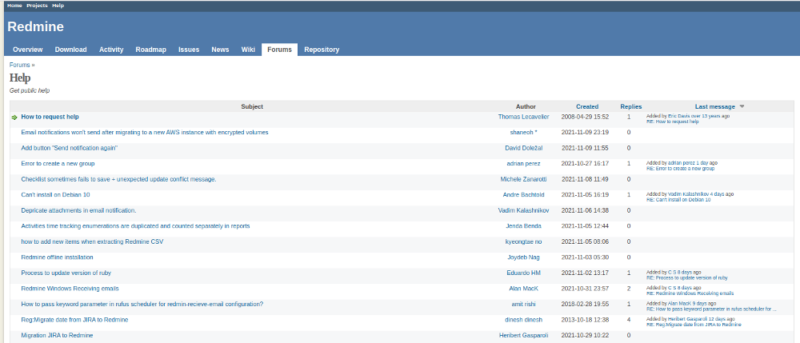
It’s not for the faint of heart, but scrolling through the topics should give you an idea of how to ask for help. While it is a downside that there’s no direct help channel for beginners, it’s also nice to see a forum that isn’t entirely inhabited by chirpy corporate bots. You win some, you lose some.
The Verdict
It’s hard to recommend Redmine for most people. It’s tough to use and presupposes a lot of knowledge of databases and even some programming. However, for people with the skills to handle it, Redmine may be an interesting choice simply because it won’t cost you a penny.
Add the versatility of an open-source program, and Redmine is a great pick for the right team. That’s a small group, to be sure, but if you think that means you, we encourage you to take it for a spin. Anybody else may want to check out monday.com’s trial instead. It’s a lot easier to handle.
Have you used Redmine? What did you think of it? Did we get it right or did we overlook a vital part of this project management solution? Let us know in the comments below and, as always, thank you for reading.
FAQ
Redmine is popular among software companies, presumably because their staff know their way around tricky software.
Redmine is entirely free, though some of its add-ons aren’t.
Yes, Redmine is a legitimate piece of project management software.


